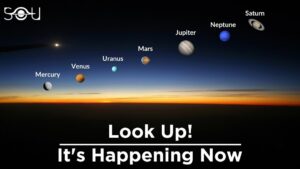If you love stargazing, you’re in for a treat this week. Five planets and a crescent moon are about to line up in the night sky, creating a stunning spectacle that you don’t want to miss. Here’s how to watch this rare cosmic event.
What is a planetary alignment?
A planetary alignment, or parade, is when several planets appear close together in the sky from our perspective on Earth. This happens because the planets orbit the sun at different speeds and distances, and sometimes they align along the same line of sight.
Planetary alignments are not very common, but they are not dangerous or harmful either. They are just beautiful celestial shows that remind us of our place in the solar system.
Which planets will be visible?
The five planets that will be visible in the night sky are Mercury, Venus, Mars, Jupiter and Uranus. Mercury is the smallest and closest planet to the sun, but also the most elusive because it is often hidden by the sun’s glare. Venus is the brightest planet and the second closest to the sun.
It is sometimes called the evening or morning star because it shines brightly near the horizon. Mars is the fourth planet from the sun and has a distinctive reddish color. It is also known as the red planet because of its iron-rich soil. Jupiter is the largest and fifth planet from the sun. It has dozens of moons and a powerful magnetic field.
Uranus is the seventh planet from the sun and the third largest. It is a gas giant with a tilted axis that makes it rotate on its side.
How to watch the planetary alignment?
The best time to watch the planetary alignment is from March 25th to 30th, just after sunset. You will need a clear view of the western horizon, where the sun sets. You will also need binoculars or a telescope to see some of the fainter planets, especially Uranus.
Here’s what you can expect to see each night:
– March 25: A thin crescent moon will be below Venus and above Jupiter in the western sky. Mercury will be below Jupiter but hard to see. Uranus will be above Venus but also difficult to spot.
– March 26: The crescent moon will be above Venus and very close to Uranus. You may need binoculars to see them both. Jupiter will have moved slightly lower and Mercury slightly higher, but still not very visible.
– March 27: The crescent moon will be about halfway between Venus and Mars. You can also look for the Pleiades star cluster above the moon with binoculars.
– March 28: The crescent moon will be near Mars, which will be very bright and orange in color. Venus and Uranus will still be close together, while Jupiter and Mercury will be almost touching near the horizon.
– March 29: The crescent moon will be above Mars and farther away from Venus and Uranus. Jupiter and Mercury will be even lower and harder to see.
– March 30: The crescent moon will be high in the sky, leaving behind the five planets. Mars will be the highest of them, followed by Venus and Uranus. Jupiter and Mercury will have set before sunset.


